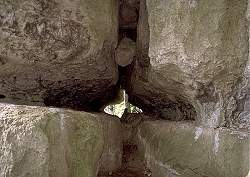Ith



South of the city Hildesheim, the North German Plain ends, and the low mountain ranges begin.
This landscape has a long history and is the origin of Grimm’s fairy tales, many names and places they mention actually exist in this area.
For example, there is an area called Sieben Berge (Seven Mountains) which is well known from the fairy tale
 Little Snow White.
Little Snow White.
The bedding in this area is not horizontal, but almost vertical, as the rocks were twisted by tectonic forces. Duinger Berg, Ith and Deister are escarpments, formed by hard limestone layers. Those hard layers resisted erosion better than the softer layers, which form valleys in between.
The limestone cliffs of the Ith are a popular climbing area. They also contain a number of small caves and shelters, only accessible to climbers. It is difficult to visit them, and the caves are not very impressing, but they are famous for the number of archaeological remains found here. They contained remains from Stone Age to the Middle Ages, in German they are called Kulthöhlen (cultic caves). The archaeological section of the Braunschweigisches Landesmuseum in Wolfenbüttel has numerous archaeological finds of this caves on display.
The caves are called Nasensteinhöhle (Nasenstein cave), Rothesteinhöhle (Rothestein cave), Soldatenhöhle (soldiers cave), Töpferhöhle (potter cave), Kinderhöhle (children’s cave) and Teufelsküche (devils kitchen). They are typically rather narrow fissure caves, high enough to stand upright inside and rather short. Some are so-called abris (shelters).
- Sights of This Region
 Lippoldhöhle
Lippoldhöhle Wasserbaum von Ockensen
Wasserbaum von Ockensen Der Lügenstein
Der Lügenstein
- See also
 Ith – Wikipedia (
Ith – Wikipedia ( )
)
 Index
Index Topics
Topics Hierarchical
Hierarchical Countries
Countries Maps
Maps Search
Search